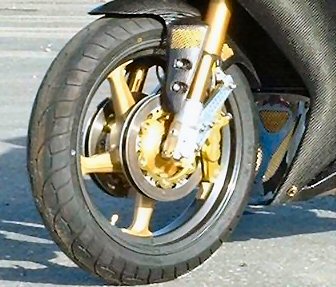Reverse rotating rotors?

These are the claims posted by the chaps who're making quite a buzz with their (now track-tested) reverse-rotating disc brakes for motorcycles:
- Reduced Steering Effort
A motorcycle equipped with reverse rotating rotors can change lean angle as easily at 180 m.p.h. as it can at 20 m.p.h. Effort can be adjusted to rider preference. Steering geometry can be set more aggressively. Rapid lean angle changes do not induce wobble or cause precession that must be resisted, therefore the static resistance of trail can also be reduced. - No Tank Slappers
It is impossible for a motorcycle that is equipped with reverse rotating rotors to experience wheel wobble or tank slap. This is because the energy that causes it is a result of the gyroscopicprecession of the front wheel in sequence with rapid lean angle changes caused by the bike the front wheel or both being misaligned with the path of travel. If that force is canceled out then a tank slapper is impossible. - Better Brake Performance
Braking feel is improved and braking effort reduced due to a dynamic increase in the swept area of the braking surface. This is because the rotors are spun faster in reverse in order to cancel the gyroscopic force of the wheel and tire. - This text is verbatim from reverserotatingrotors.com

The website has a comprehensive Why It Works page, but before I dive into the precession, slip angle, gyroscopic forces discussion (the two page print out is in front of me now), I think it makes sense. I remember reading a brit bike mag which featured an R1 with a quad front disc setup (two close-set rotors on each side with a composite calliper set). The idea was that the quad discs would offer the same braking force as the normal 320 mm twin discs, but with a far smaller rotor diameter. This would reduce the gyroscopic force generated by the rotor (and therefore, the entire front wheel) and make the R1 steer with less effort, and quicker. The journalist (mag name and his name escape me right now) found that the idea seemed to work.
In the case of reverse rotating rotors, instead of reducing the gyroscopic inertia (short for inertia due to gyroscopic forces) by cutting down on rotor diameter, the reverse rotation would, in effect, generate negative (substitute for in the opposite direction) gyroscopic force, effectively cancelling out/reducing the total gyroscopic force being generated. That should lighten steering effort. Obviously, since 80 per cent (usually) gyro stability for a mobike comes off the rear wheel, this would not impact the motorcycle's overall stability. And for that very reason, you would not want to use the idea on the rear brake. That's me, with my class six physics trying to reason this out. Sheesh, I had to add a disclaimer to this post as well.
Credits: Claims text from reverserotatingrotors.com,
Quad R1 pic from sportsbikerider.com





















No comments:
Post a Comment